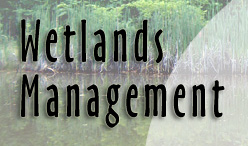|
|
|
|
|
|
Wetland types |
|
Peatlands |
|
Formation |
page 2 of 7 |
Peat dominated wetlands need two primary factors to
develop—excess water and excess peat accumulation. A positive water
balance is needed to develop bogs and fens. More precipitation, in
the form of rain and snow, needs to fall than disappear through
 evapotranspiration. Evapotranspiration is the loss of water to
the atmosphere through the combined forces of evaporation and plant
transpiration. In most cases, precipitation is 30 percent to 50
percent more than evapotranspiration. Peatlands require a humid
environment year-round, so an even distribution of precipitation
throughout the months and relatively low sun intensity is necessary
for optimal peatland development. The second requirement is that
peat moss is produced and accumulated faster than it decomposes. evapotranspiration. Evapotranspiration is the loss of water to
the atmosphere through the combined forces of evaporation and plant
transpiration. In most cases, precipitation is 30 percent to 50
percent more than evapotranspiration. Peatlands require a humid
environment year-round, so an even distribution of precipitation
throughout the months and relatively low sun intensity is necessary
for optimal peatland development. The second requirement is that
peat moss is produced and accumulated faster than it decomposes.
Peatlands generally form under two different circumstances. Some
open water lake basins gradually fill in from the surface from
Sphagnum mosses, reeds, sedges, and grasses growing and dying. The
dying vegetation decomposes slowly due to the low oxygen conditions
under water and due to the cool environment. These plants continue
to grow and gradually move towards the center of the lake creating a
quaking bog. The floating surface continues to be colonized by
plants and the process is continued. This type of bog is called a
quaking bog because when you walk on it, it “quakes” or undulates as
you walk on it due to the water underneath it.
The second type of bog formation is called paludification.
Paludification is the process by which the bog grows outside of its
basin and flows across the terrestrial landscape to form peat on
terrestrial areas. The peat continues to accumulate and compress,
until it eventually causes a perched water table near the surface of
the mineral soil. The peat dominated wetland, continue to grow and
evolve from the formerly terrestrial landscape, until a bog exists.
|

